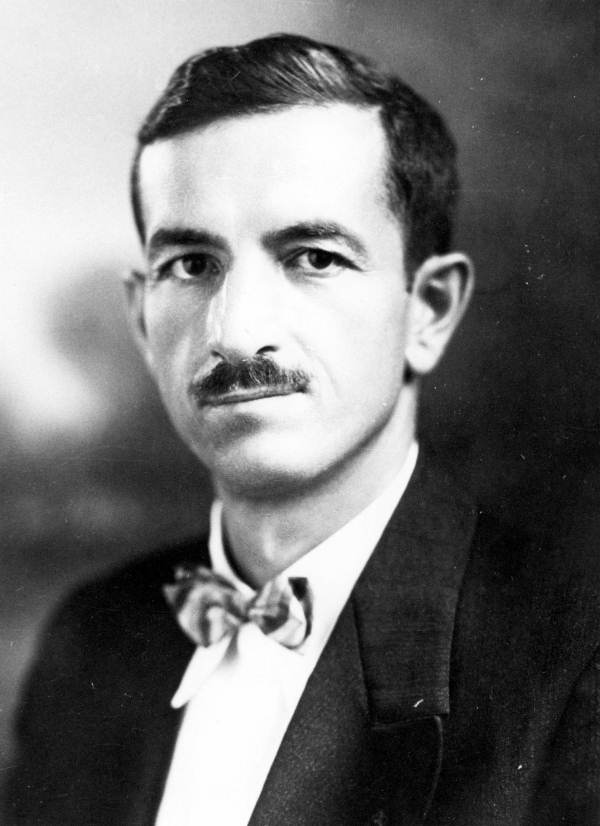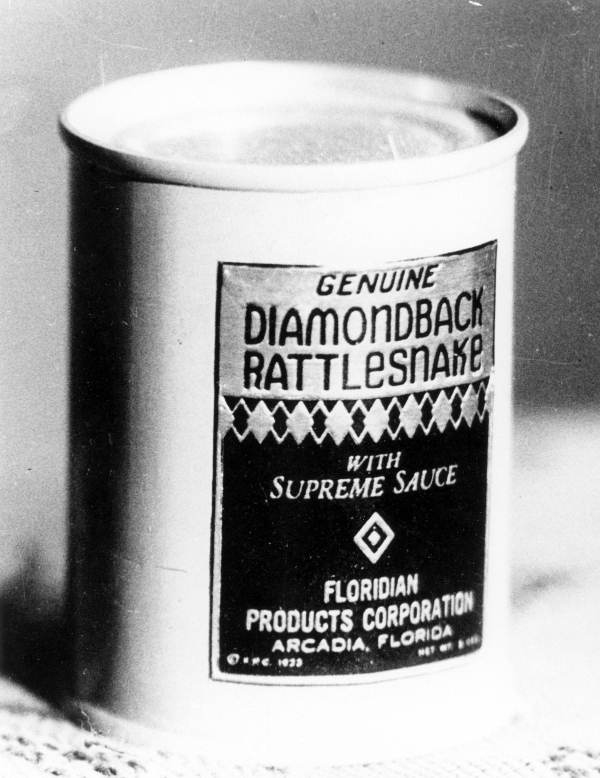Description of previous item
Description of next item
Please Pass the Rattlesnake
Published July 7, 2014 by Florida Memory
The diamondback rattlesnake doesn’t exactly enjoy the best reputation among Florida’s wildlife. Generations of Floridians and visitors have been warned of the potentially deadly consequences of its bite, and as a result this venomous reptile is seldom a welcome sight when spotted.
That being said, rattlesnakes have also been a subject of great curiosity, when viewed from a safe distance at least. Eager entrepreneurs have tried in a number of ways to tap into this cautious enthusiasm over the years, including reptile shows, theme parks, reptile-skin gifts and clothing, and even by offering reptile meat as a food item.
George Kenneth End of Arcadia, Florida was one such businessman who made a living selling rattlesnakes in any way he could. Around 1930, he was helping his two young sons skin a rattlesnake they had just killed when the idea suddenly struck him to try cooking the meat to see what it would taste like. End found the meat tender and the flavor good, and he began experimenting with it to see how it could best be prepared as a marketable product.

An advertisement for the Floridian Products Corporation, showing a list of its various products (1933).
The result was the Floridian Products Corporation, Rattlesnake Division. End began selling every part of the snake that might capture the whimsy of a customer, from the skin to the rattles, the fangs, oil made from snake fat, and even live snakes themselves. Among the most popular products was End’s “Genuine Diamondback Rattlesnake with Supreme Sauce,” a canned portion of rattlesnake meat prepared with a sauce of meat stock, mushrooms, and heavy cream. Advertisements recommended serving the meat in pastry shells or on thin slices of toast as an appetizer for cocktails. End and his associates promoted the meat as a delicacy, and encouraged customers to “be the first in your neighborhood to give a rattlesnake dinner.”
End’s bid for greatness as Florida’s main purveyor of rattlesnake products was successful. He first set up a factory for processing the rattlesnakes in Arcadia, not far from Florida’s Gulf Coast near Port Charlotte and Sarasota. The surrounding territory was largely undeveloped and full of scrub palmetto and other heavy growth, which made it ideal hunting grounds for the snake hunters who captured rattlesnakes to bring to End for processing. Later, as business picked up, End moved his main operation to Tampa, where he established his own “Rattlesnake Cannery and Emporium” in a two-story building at the corner of Bridge Street and Gandy Boulevard. In addition to processing the snakes, he also put on shows for visitors, who gasped in amazement as he and his associates handled the live rattlers and “milked” them to obtain the venom for medical purposes. End even managed to obtain permission to operate a post office at the site, naturally called “Rattlesnake.” Tourists were only too happy to send mail from this location, since it bore the unique “Rattlesnake, Fla.” postmark.

The original headquarters of the Floridian Products Corporation in Arcadia. Pictured out front are representatives of Elks Magazine, who were on their annual goodwill tour around the United States (circa 1933).
End’s success stemmed in part from the novelty and allure of his product, but his skills as a promoter were none too shabby. In addition to his “Rattlesnake” post office and attractive stop-over for tourists, he also at times took to the road to promote his products. Anyone who partook of a rattlesnake meal was furthermore entitled to membership in one of End’s reptile-related “clubs,” and would receive a membership card with their order. No doubt many a tourist left Florida proudly credentialed as a member of the “Reptile Science League,” the “Ancient Epicurean Order of Rattling Reptile Revelers,” or the “Subtle Society of Snake Snackers.”

A membership card for George K. End’s “Rattling Reptile Revelers,” obtainable with the purchase of a can of End’s rattlesnake with supreme sauce. This card was found in the collection of longtime Florida folklorist Stetson Kennedy at the State Archives of Florida (circa 1933).
As the shadow of World War II emerged on the horizon at the start of the 1940s, George End was threatened with the loss of his most vital helpers in the rattlesnake industry, the young men of soldiering age who went out and actually caught the snakes. Unfazed, he reputedly claimed that Rattlesnake, Florida would “go on to bigger things and better things, in spite of hell, Hitler, and high water.”
He was almost right. On July 27, 1944, End was working with a six-foot rattler that had just arrived at his headquarters when the snake struck at his right hand between his thumb and forefinger. For all the time George End had spent working with deadly rattlesnakes, he had never in his life been snakebitten before, but once was enough. He administered anti-venom to himself, but it was ineffective. He died in a matter of hours.
The Rattlesnake, Fla. post office and the emporium at Bridge Street and Gandy Boulevard closed down eventually, and End’s rattlesnake empire began to fade into memory. Mrs. End sold the cannery equipment along with its patents and formulas to herpetologist Ross Allen, whose Reptile Institute at Silver Springs, Florida served as both a tourist attraction and a site for anti-venom research.

Ross Allen milking a rattlesnake for its venom, which could then be used to create anti-venom and conduct research (circa 1940s).
George End’s rattlesnake attraction was one of a multitude of Florida tourist spots whose peculiar nature and humble origins make them treasures of the history of the Sunshine State. What kinds of tourist attractions do you remember from Florida’s past? Did any of them have to do with snakes or other reptiles? Tell us your story when you share this article on Facebook or Twitter.
Cite This Article
Chicago Manual of Style
(17th Edition)Florida Memory. "Please Pass the Rattlesnake." Floridiana, 2014. https://www.floridamemory.com/items/show/295188.
MLA
(9th Edition)Florida Memory. "Please Pass the Rattlesnake." Floridiana, 2014, https://www.floridamemory.com/items/show/295188. Accessed December 22, 2025.
APA
(7th Edition)Florida Memory. (2014, July 7). Please Pass the Rattlesnake. Floridiana. Retrieved from https://www.floridamemory.com/items/show/295188

 Listen: The World Program
Listen: The World Program

